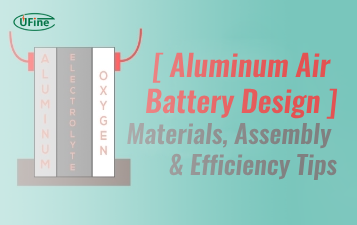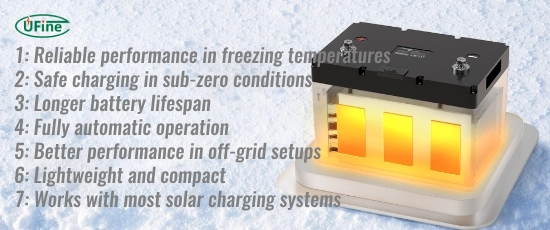Looking for the best way to keep your battery running in freezing temperatures? A heated lithium battery is the key. These batteries are specially designed to perform in cold weather, where regular batteries often fail. Whether you live in a snowy region, camp in winter, or power equipment in the cold, heated lithium batteries offer game-changing benefits.
In this article, we’ll explore the 7 significant advantages of using a heated lithium battery in cold climates, explain how they work, and answer some of the most common questions people have.
Part 1. What is a heated lithium battery?
A heated lithium battery is a type of lithium-ion battery that comes with a built-in heating system. This system automatically warms the battery when temperatures drop below a certain level, usually around 0°C (32°F).
Why is this important? Cold weather can severely reduce battery performance. Lithium batteries, in particular, don’t charge well in freezing temperatures. A heated lithium battery solves this problem by keeping itself warm enough to work efficiently even in extreme cold.
Part 2. Why do cold temperatures affect batteries?
Batteries rely on chemical reactions to store and release energy. In cold weather, these chemical reactions slow down. This leads to:
- Lower capacity
- Slower charging
- Reduced battery life
- Possible permanent damage if charged below freezing
Traditional lithium batteries can’t charge safely below 0°C, a common issue in many parts of the world during winter. A heated lithium battery fixes this by managing its temperature.
Part 3. How does a heated lithium battery work?
A heated lithium battery contains:
- Temperature sensors to detect when it’s too cold
- Heating elements powered by the battery itself or external sources
- A battery management system (BMS) that controls the heating process
When the temperature drops, the BMS turns on the heater. Once the battery is warm enough (usually above 5°C), it allows charging and discharging safely.
This process is automatic, so you don’t need to do anything — the battery takes care of itself.
Part 4. Advantage 1: Reliable performance in freezing temperatures
This is the most significant benefit.
A heated lithium battery works consistently in temperatures as low as -20°C or lower. It keeps your devices, vehicles, or systems running smoothly when regular batteries fail.
Whether you’re using it in:
- RVs and camper vans during winter
- Solar storage in cold regions
- Off-grid cabins in snowy areas
- Ice fishing gear
…you won’t have to worry about battery failure due to the cold.
Part 5. Advantage 2: Safe charging in sub-zero conditions
Charging a lithium battery below freezing can permanently damage it.
Standard lithium batteries can’t accept a charge properly when temperatures are below 0°C. This can lead to:
- Lithium plating (which shortens battery life)
- Internal damage
- Fire or explosion in extreme cases
Heated lithium batteries warm themselves before allowing a charge, making the process safe and worry-free.
Part 6. Advantage 3: Longer battery lifespan
Cold temperatures shorten battery life — but not with a heated lithium battery.
Maintaining a safe internal temperature prevents the battery from stress and damage caused by freezing conditions. This results in:
- More charge cycles
- Better long-term performance
- Lower replacement costs
It’s a smart investment, especially for year-round use of batteries in harsh climates.
Part 7. Advantage 4: Fully automatic operation
You don’t need to be a tech expert to use a heated lithium battery. It’s plug-and-play.
The built-in BMS and thermostat do everything:
- Detect temperature
- Activate the heater
- Allow safe charging and discharging
There’s no need to manually warm the battery, add insulation, or worry about monitoring conditions. Just install it and let it do its job.
Part 8. Advantage 5: Better performance in off-grid setups
Off-grid systems often rely on solar panels and battery storage. Standard batteries can fail in cold areas, especially overnight when temperatures drop.
A heated lithium battery keeps your energy system running, even if the sun isn’t shining or temperatures fall below freezing. This is especially important for:
- Remote cabins
- Backup power systems
- Winter Camping
- Emergency power
It ensures you always have reliable energy, no matter the weather.
Part 9. Advantage 6: Lightweight and compact
Unlike bulky lead-acid batteries with added insulation, heated lithium batteries are compact and light. You don’t need extra space or weight to keep them warm.
This is a massive advantage in:
- RVs
- Boats
- Portable power stations
- Mobile solar setups
You get maximum power in a smaller, lighter package.
Part 10. Advantage 7: Works with most solar charging systems
Many people use lithium batteries in solar setups. The good news?
Heated lithium batteries are compatible with most solar charge controllers. They can be integrated into your existing system with little or no changes.
Most models also include low-temperature protection, so you don’t have to worry about accidental damage when temperatures drop unexpectedly.
Artikel Terkait: How Battery Heaters Improve Performance in Low Temperatures
Part 11. FAQS About Heated Lithium Batteries
What is the lowest temperature a heated lithium battery can operate in?
Depending on the design, most models can work in temperatures as low as -20°C (-4°F) or lower. Always check the manufacturer’s specs for exact numbers.
Can I use a regular lithium battery in cold weather?
Yes, but with risks. Regular lithium batteries can’t be charged below 0°C and may get damaged. Heated lithium batteries are much safer and more reliable in cold conditions.
Does the heater use a lot of power?
Not really. The heating system is designed to be energy efficient. It only turns on when needed and uses minimal power compared to the battery’s total capacity.
Do I need a special charger for a heated lithium battery?
In most cases, no special charger is required. Heated lithium batteries work with standard lithium chargers, especially those with low-temperature cutoffs.
How long do heated lithium batteries last?
Proper use can last 10+ years or over 3000 charge cycles, depending on the brand and usage. The heating system helps extend battery life in cold climates.
Pro Tip: When buying a heated lithium battery, look for models with smart BMS, low-temperature charging protection, and certifications like UL or CE for safety.
Related Tags:
More Articles

Aluminum Air Battery Design: Materials, Assembly & Efficiency Tips
An aluminum air battery uses aluminum and air to generate power. Learn its materials, assembly steps, and tips to boost energy output and efficiency.
How to Choose the Best Floor Scrubber Battery for Commercial Cleaning?
Selecting the ideal floor scrubber battery ensures a long runtime, rapid charging, and minimal maintenance for efficient commercial cleaning operations.
Battery for Blower vs Battery for Leaf Vacuum: Which One Should You Choose?
Battery for blower vs leaf vacuum—learn the key differences in power, fit, and runtime to choose the right battery for your outdoor tool needs.
How to Choose the Right Battery for Blower?
Choosing the right blower battery? Consider voltage, capacity, chemistry & usage. This guide helps match the best battery for peak performance.
How to Choose the Best Insulated Battery Box for Lithium Batteries?
Choosing the Best Insulated Battery Box for Lithium Batteries? Discover key factors such as size, material, and safety for optimal protection and performance.





